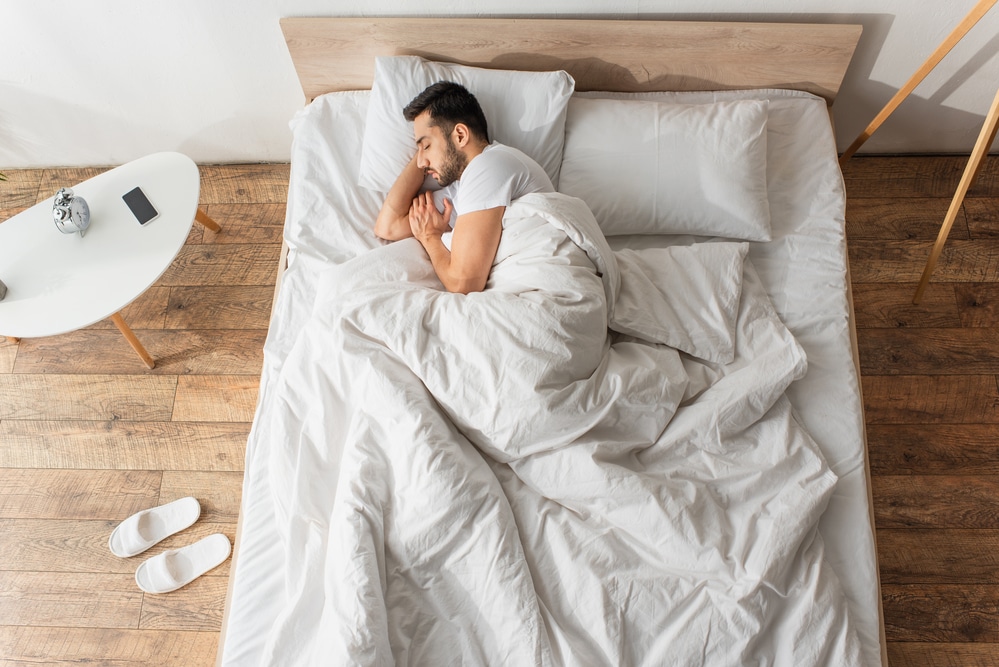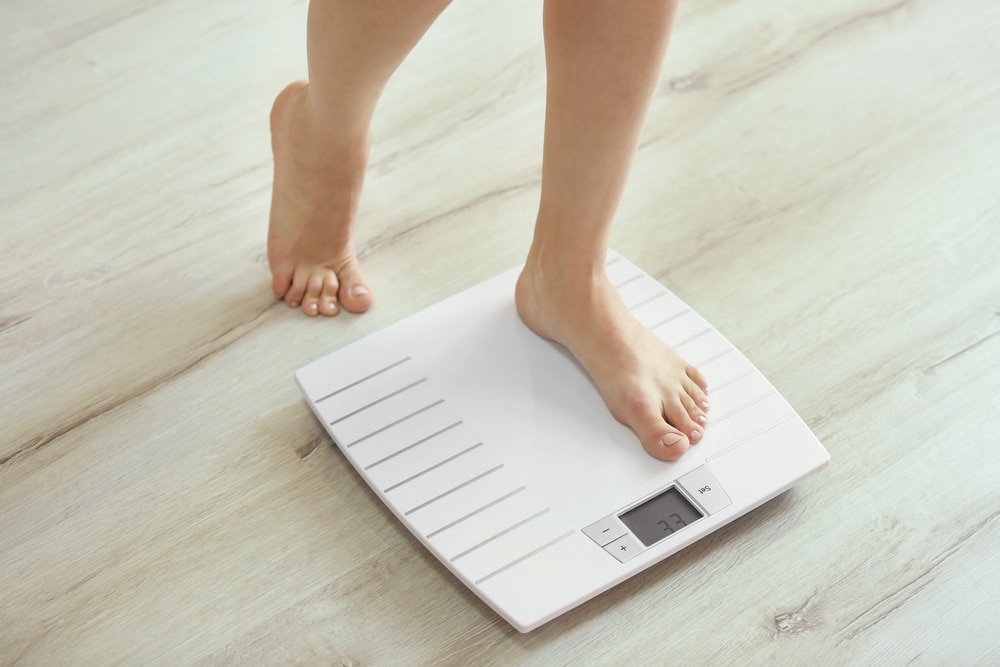Last Updated on
The sciatic nerve is the longest nerve in the body. When it becomes compressed or irritated, you’ll experience pain or tingling in your legs, feet or bottom. An estimated 5%-10% of patients with lower back pain will suffer from sciatica, which often makes getting a restful night extremely difficult.
Thankfully, there are a few steps you may take to enhance the quantity and quality of sleep you get when you have sciatica. Here’s how to prevent sciatica pain while sleeping for a better night’s sleep.
Why Does Sciatica Hurt More at Night?
After a night in bed without the stresses and strains of the day, you would normally assume that you will wake up with less low back pain than before. Unfortunately, sciatica is often worse first thing in the morning, and sciatica at night can even become unbearable. Why is this?
Sciatica is caused by pinching or inflammation of the sciatic nerve. When you lie down, the spaces in your spinal column become more compressed. This can limit the space for your nerves and make your sciatica even worse. Improper sleep posture is one of the main culprits for increased overnight sciatic pain.
To avoid aggravating your sciatic nerve further, take a look at our recommended sleep positions for sciatica sufferers.
The Best Positions for Sleeping With Sciatica
If you have sciatica, there is no certain sleeping position that will be comfortable for you. Try out the following sciatica sleep positions to see what works best for you. What brings a lot of relief for one sufferer can be almost unbearable for another. So, take the time to see how your body reacts to the following popular sleeping positions for sciatica sufferers.
Sleeping on Your Side
Many people who have problems sleeping with sciatica find that sleeping on their side helps ease their symptoms. Lying with your most painful side upwards can help to reduce the amount of pressure on your irritated nerve for better pain relief.
Pillow Between Your Knees
If side sleeping is helping to prevent your sciatica pain but is creating pressure on your hips and pelvis, try sleeping with a pillow between your legs while side sleeping. This will expand the space and put your thighs in a more natural position to limit strain on the nerve. You may also like to try inserting a thin pillow between your mattress and your waist to better support your spine.
Elevating Your Legs
If you cannot sleep on your side, you may want to try sleeping on your back with your legs in an elevated position. Some sciatica sufferers find that lying on their back and placing a pillow under their knees helps ease the lower back tension, thus freeing the nerve. You can experiment with what feels best by adding or removing pillows until you find relief with a knee position that is comfortable for you.
You could also try keeping just your lower legs elevated throughout the night, particularly if you find it difficult to sleep with your knees raised. In either case, once you’ve found a position that gives you pain relief, it’s best to avoid switching positions throughout the night while you sleep. To avoid this, you could try placing tennis balls in your pocket or perhaps wedging yourself in with pillows on either side to limit your movements.
Foetal Position
If neither side-sleeping nor sleeping on your back with your knees in an elevated position works for you, you may want to try out sleeping in the foetal position. A word of warning, though, this position can be very painful for some sciatica sufferers.
However, for others, it can open up the space between their vertebrae. A reduction of space between your vertebrae when lying on your back can exacerbate your nerve pain, so this position is well worth trying out.
To adopt the foetal position, lie on your side and bring your knees slowly up towards your chest so that your body forms a curved “c” like shape reminiscent of the position of a baby in the womb. If you’re in a lot of pain, adopt the position gradually. You can do this by adjusting yourself slowly from lying flat on your side, gradually raising your knees until you find your sweet spot for pain relief and better sleep.
Pillow Under Lower Back
To help support your spine when you are sleeping on your back, you may also wish to try placing a pillow or a rolled-up towel between your lower back and your bed. This method will improve your contact with the bed, thus helping to put your spine into a neutral position while also providing extra support to your pelvis and reducing your pain. Having the right mattress can also ease up the pain you experience with your back.
Sleeping Positions to Avoid
While you’ll want to try out the above-recommended sleeping positions for sciatica sufferers, some sleeping positions can make your condition worse. Here are the sleeping positions to avoid when you have sciatica.
Sleeping On Your Stomach
For most people, sleeping with sciatica pain becomes almost impossible when they sleep on their stomachs. However, if you find that arching your back relieves your sciatic pain, a stomach sleeping position may work for you.
Sleeping With Twisted Hips
If you sleep with a twisted back or hips, you will exacerbate your sciatic nerve, so it’s best to avoid getting yourself into these types of sleeping positions when trying to sleep with sciatica.
Change Your Mattress to Help Sleeping With Sciatica
If you are struggling to sleep with back pain, changing your mattress could be an important step to improve sleep with or without sciatica pain. Soft or sagging mattresses are to be avoided, so if your bed is getting on and has seen better days, you should consider replacing it.
A medium-firm or firm mattress is recommended for back pain sufferers and those with sciatica pain in particular. You need a good, supportive base to relieve the pressure on your spine by promoting correct spinal alignment. An unsupportive sleeping surface, such as a sagging foam or overly soft mattress, can contribute to your discomfort and make sleeping with sciatica even worse.
If replacing your mattress isn’t an option for you, you could try placing a piece of plywood between your mattress and the slats or even consider putting your mattress directly on the floor. These are not long-term solutions, but they could be a temporary way to help you to get a good night’s sleep and ease your back pain while you’re in the process of changing your mattress or waiting for your sciatic pain to ease.
Sleeping On Your Floor
Sometimes sleeping in bed can aggravate your sciatica. If this is the case, you may want to try lying on your floor. To get a little bit of comfort for your pressure points, use a yoga mat or even a thin camping mat. You don’t want too much padding, as this will make your sciatica just as bad as in a bed. Try some of our recommended sciatica sleeping positions, or find a comfortable position that makes the pain more bearable for you.
If you have one spare, you may want to try spending the night on an inflatable camp mattress – this will allow you to inflate your sleeping surface to just the right level of hardness to relieve the pressure on your nerves without the hardness of the floor, making you stiff in the morning.
You may also find it easier to fall asleep on a camp bed than on the ground. Beds with adjustable firmness levels are a good solution for sleeping with sciatica and back pain in general.
Other Ways to Manage Sciatica Pain for a Better Night’s Sleep
Aside from your sleeping position, there are other strategies that you can try to improve your quality of sleep with sciatica. Here are some of the most successful ways to help reduce your sciatica at night.
Warm Bath Before Bed
It is taking half an hour to relax in a warm bath or shower before bed can help you to sleep better with sciatica. The warm water will promote circulation and reduce inflammation, as well as relax the nervous system. While the positive effects won’t last all night, it is a good way to make a pain-free start to your night.
Gentle Stretching Exercises Before Bed
Whether it’s yoga or your recommended exercises for sciatica, some gentle stretching just before you go to bed can reduce pressure on your sciatic nerve, improving circulation and helping you to unwind – all beneficial to a restful night with minimal back pain.
Sleep With a Body Pillow
A full-length pillow can help you to adjust your nocturnal posture so that your sciatic nerve is less compressed. If you go to sleep on your side but frequently wake up on your stomach in pain with sciatica, a body pillow can help you to maintain a side-sleeping position throughout the night better, preventing you from turning over.
Join a Group Exercise Programme
In the past, while people with sciatica were often prescribed bed rest, after multiple studies, today, the NICE (National Institute for Health and Care Excellence) Sciatica Recommendations include remaining active and joining a group exercise programme within the NHS.
Keeping your body active under the supervision of a qualified practitioner can help to improve how you sleep with sciatica and ensure that you get the correct medical advice for your lower back pain.
Improve Your General Bedtime Routine
Avoid caffeine, screens, and alcohol for at least two hours before bedtime. Also, try to stick to the same waking and sleeping times and ensure that your bedroom is at a comfortable temperature. While this medical advice is non-sciatica specific, you should sleep better and heal more quickly by improving your sleep routine.
Sciatica Stretches You Can Do In Bed
If your sciatica pain wakes you up in the night and you’re unable to get back to sleep, or if you wake up in the morning in pain, here are some sciatica-relieving exercises that you can try in bed to relieve your lower back pain.
While these easy sciatica exercises should help you get your day started, do not force or strain yourself. If you have any doubts about the suitability of any specific exercises for your condition, always consult with your doctor first.
Knees up to Chest
Lie on your back in bed. Slowly bring your knees up and hug them to your chest, rounding your back. Hold for 15 seconds and repeat five times.
Knee to Shoulder
Lying on your back, place your hands behind your left knee and slowly stretch your leg forwards, bringing it over towards your right shoulder. Hold for 20 seconds, then repeat four times before changing to your right side.
Figure 4
Still, on your back in bed, lie with your knees bent and feet flat on your mattress. Take hold of your right lower leg and bring it forward until it is in front of your left thigh, creating the figure of the number four.
Grasp your left leg with both hands behind the knee and stretch it towards you as you push back with your right one. Repeat three times for each side.
Get the Relief You Need
Sleeping when you’re suffering from sciatica pain can be extremely difficult. Even lying down can be painful, preventing you from getting the sleep you need to help speed recovery.
If sciatica is stopping you from sleeping at night, try to sleep on your back or side, accompanied by extra pillows to support your back and pelvis if required. Although these tips on how to prevent sciatica pain while sleeping may not work for everyone, they’re a start.
If you’re experiencing severe pain and struggling to cope, make sure that you see your doctor as soon as possible. For milder cases, make sure you try out the above tips for sleeping with sciatica, especially taking warm baths with gentle stretching exercises to improve circulation and promote relaxation.
Kelly is an expert in consumer product research, which is very important when it comes to finding the most useful and aesthetically pleasing items for your home. This became her passion after finding it very time-consuming to wade through all the product information online.
She has keen attention to detail which she brings to her articles. Kelly’s goal is to help you find what you need without spending too much time searching for it.



